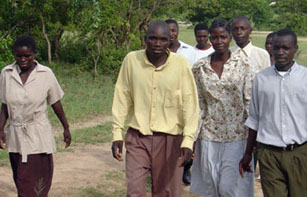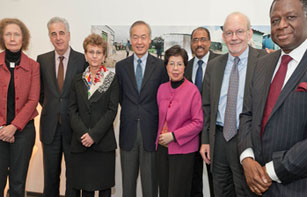
(From left): Michel Sidibé, UNAIDS Executive Director; Irene Khan, human rights activist; Michelle Bachelet, UN Women Executive Director; Babatunde Osotimehin, UNFPA Executive Director. 24 February 2011.
Credit: UNAIDS/B. Hamilton
HIV is the leading cause of death among women of reproductive age worldwide. For this to change, the global HIV response must fully recognize the significant role that gender inequality plays in increasing women and girls’ vulnerability to HIV.
At a high-level consultation, jointly organized by UNAIDS, UNFPA and UN Women, influential experts, leaders and advocates came together to discuss how sexual and reproductive health, and the rights of women and girls living with HIV can be enhanced and protected.
The event which took place on 24 February, was co-hosted by Michel Sidibé, Executive Director of UNAIDS, Michelle Bachelet, UN Women’s Executive Director, and UNFPA’s Executive Director, Babatunde Osotimehin.
Concerns were expressed about the reported violations of the sexual and reproductive rights of women and girls living with HIV, which impact on their desire to have children, as well as their access to prevention, treatment, care and support. Participants described the experience of some young women living with HIV who face stigma and discrimination when accessing HIV and sexual and reproductive health services. Examples were shared of HIV positive women who were advised not to engage in sexual relationships and scolded when seeking health care when pregnant, which presented a barrier to them accessing prevention of mother-to-child HIV transmission and safe delivery services.
Participants identified strategic opportunities to protect and promote sexual and reproductive health and rights, including through improved and sustained investment in women and girls living with HIV. There was consensus that a gender-sensitive AIDS response can help countries move towards universal access to HIV prevention, treatment, care and support services and the Millennium Development Goals. This approach is that recommended by UNAIDS and in line with the UNAIDS Agenda for Women and Girls , and the UNAIDS Strategy 2011-2015 .
Empowering young people, particularly girls and women, living with HIV to defend their rights and have access to education, information, and services would be a major revolution
UNFPA Executive Director, Mr Babatunde Osotimehin
Arguing for the better integration of HIV in development plans, Dr Nafsiah Mboi, Secretary of the National AIDS Commission, Indonesia emphasized, “HIV is not a health issue, it’s a development issue.”
During the consultation’s opening session, Michel Sidibé spoke of the UNAIDS Strategy and the Agenda for Women and Girls, reinforcing UNAIDS commitment to making gender equality and women’s health and rights a core part of the global AIDS response. He encouraged women and girls living with HIV to raise their voices for social change, despite the risk of stigma, discrimination and social exclusion:
"We must take AIDS out of isolation and provide young girls with opportunities to negotiate their sexual relationships and receive sexuality education so that they can protect themselves from infection,” said Mr Sidibé. “If we don't do this, our vision of zero new infections will remain a dream."
Sharing UN Women’s response to these fundamental issues of gender inequality, Michelle Bachelet contended, "we need to integrate not only services provided but also ongoing political and social movements, including the HIV and women's empowerment movements."
Ms Bachelet also argued that human rights alone is not a sufficient argument for investing in women and HIV, rather, “what is needed is a political, economic and social case.” She also stressed the importance of all involved working together in a coordinated way.
Dr Osotimehin commented on the importance of strengthening the rights of women and girls. “Empowering young people, particularly girls and women, living with HIV to defend their rights and have access to education, information, and services would be a major revolution,” he said.
The outcomes of the discussion will serve as input for the 55th meeting of the Commission on the Status of Women as well as the 2011 High-Level Meeting on AIDS in June.
Commission on the Status of Women
The 55th session of the CSW runs until 4 March 2011. Representatives from Member States, UN entities, and ECOSOC-accredited non-governmental organizations from all regions of the world are gathered to evaluate progress on gender equality, identify challenges, set global standards and formulate concrete policies to promote gender equality and advancement of women worldwide.













